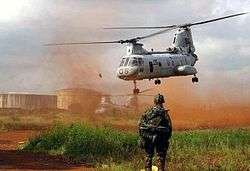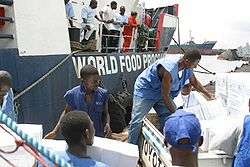Joint Task Force Liberia

Joint Task Force Liberia was a joint task force formed from August to October 2003 in response to the crisis that developed during the Second Liberian Civil War.[1] The ongoing civil war destabilized the area and created a large number of refugees as rebel forces closed in on Monrovia and took over Bushrod Island. As a result, the Freeport of Monrovia closed, causing food shortages.
As the crisis unfolded, U.S. Ambassador to Liberia John W. Blaney requested military assistance. U.S. Secretary of Defense Donald Rumsfeld approved deployment of U.S. forces on July 20, 2003[2] and soon afterwards, the U.S. military established Joint Task Force Liberia.
Formation and deployment of the task force

In July, Marines from a forward deployed Fleet Antiterrorism Security Team (FAST) left Naval Station Rota, Spain for Liberia. The FAST platoon reinforced the embassy security and began non-combatant evacuation operations. After a month of the platoon of Marines being alone to defend the Embassy Compound, the 26th MEU, which had steamed at full speed for 2 weeks from the coast of Ethiopia finally arrived off shore.
Members of the Southern European Task Force formed the headquarters element of the task force while the Iwo Jima Amphibious Ready Group with the 26th Marine Expeditionary Unit provided the operational forces. The Task Force Command Element Forward embarked aboard the USS Iwo Jima (LHD-7) with the intent of keeping a small footprint ashore.[3]
On August 14, 2003, the Iwo Jima Amphibious Ready Group conducted an amphibious operation and landed about 150 Marines at Roberts International Airport and another 50 at the Freeport of Monrovia on Bushrod Island. Nigerian Army forces also deployed as part of an Economic Community of West African States peacekeeping force. The Joint Task Force Liberia and ECOWAS forces quickly stabilized the area and the United Nations brought in humanitarian aid.[4]
President Charles Taylor left the country soon afterwards under pressure from the international community, and the stage was set for the arrival of first an ECOWAS interim peacekeeping force, ECOMIL, and then the UN peacekeeping force the United Nations Mission in Liberia.
Notes
| Wikimedia Commons has media related to Joint Task Force Liberia. |
- ↑ Rhem, Kathleen T. "American Troops Set to Assist West African Force in Liberia", U.S. Department of Defense Website, August 13, 2003. Retrieved on October 23, 2008.
- ↑ Rhem, Kathleen T. "21 Marines Sent Into Liberia at Ambassador’s Request, July 21, 2003. Retrieved on October 24, 2008.
- ↑ Collins, Thomas W. "Joint Efforts Prevent Humanitarian Disaster in Liberia", Army Magazine, February 2004.
- ↑ Collins, Thomas W. "Joint Efforts Prevent Humanitarian Disaster in Liberia", Army Magazine, February 2004.
Further reading
- Colonel Blair A. Ross (U.S. Army), 'The U.S. Joint Task Force Experience in Liberia,' Military Review, May–June 2005, p. 60-67. at http://usacac.leavenworth.army.mil/CAC/milreview/download/English/MayJun05/ross.pdf
- Geraci (2005). Expert Knowledge in a Joint Task Force Headquarters. JFQ. at http://www.dtic.mil/doctrine/jel/jfq_pubs/1238.pdf